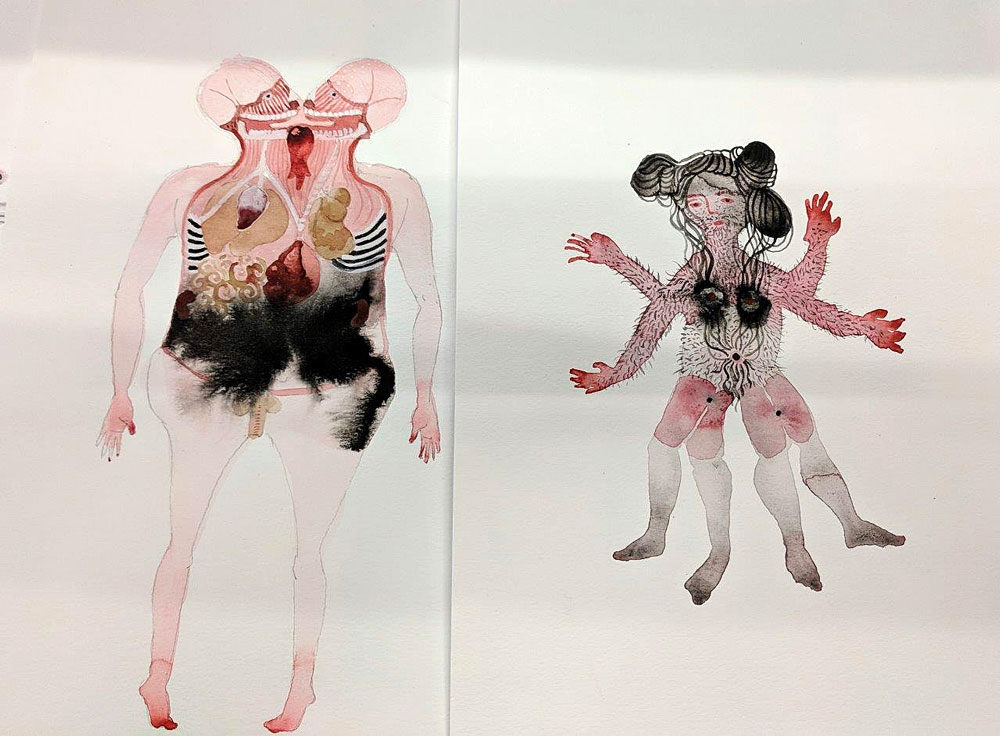
During her time as Michele Larose – Osler Library Artist-in-Residence, Caroline Boileau explored different European and Asian medical texts dating from the 15th to the 19th centuries, focusing particularly on representations of the female body.
The resulting Corps qui hantent d’autres corps exhibition is a dialogue between the long, slow time of centuries-old documents and the fast, lively – near-visceral – time of the artist’s plastic explorations.
We recently spoke with Boileau about the exhibit currently on display until April 15 in the Reading Room at Rare Books and Special Collections, McLennan Library Building (3459 McTavish), 4th floor. For opening hours, click here. Get more information on the Michele Larose – Osler Library Artist-in-Residence Programme. Get more information about the exhibit.
Can you tell us briefly about the exhibit?
Since September, I have had the pleasure of being artist-in-residence at McGill’s Osler Library of the History of Medicine, where I am exploring various medical works from Europe and Asia dating from the 15th to the 19th centuries, focusing particularly on representations of the female body. This exhibition marks the end of the residency and reflects my thoughts, trials and discoveries.
Many things inhabit the exhibition: On the touch screen at the entrance, visitors can explore four videos and visit my blog documenting the process of the residency leading up to the exhibition; the exhibitions cases of the Reading Room bring together notebooks and sketchbooks, drawings, objects and historical documents; on one of the table, an artist book, a collection of images related to obstetrics, can be consulted on site with a choice of accompanying audio. Every Thursday from 10 to 6, for the duration of the exhibition, I will be working on another artist book while waiting for visitors. Please come and visit with me!
Why does this topic interest you?
Working from a feminist perspective, with a strong interest in health – intimate, public, social and political – I create works that are developed through a multidisciplinary practice through installation, drawing, video and performance.
For the past 20 years, I have developed projects in dialogue with different contexts: hospitals, medical history libraries, special collection libraries, biology laboratories, art and history museums, parks and public spaces. These places, the people who gravitate in and around them, the collections and objects they house, become materials that question and challenge my ways of doing things, enabling me to consider different work strategies, visual devices and plastic forms.
The residency at Osler Library of the History of Medicine has put me in contact, and in dialogue, with a collection that has fascinated me for years. It is exactly the type of residency I am looking for, a place where I am confronted with different ways of doing research, in contact with specific ‘objects’ and in dialogue with people I wouldn’t necessarily meet in the art community.
Why is this topic important for people to engage with?
In historical documents I have consulted during my residency, the generic body is male and representations of the female body are rare. This invisibility of women’s bodies raises the question of other ‘invisibilities,’ other people who were misrepresented or not represented at all. Visibility and invisibility of different realities, bodies and experiences is something that needs to be understood and addressed. The place of women in society in general and in medicine in particular still needs to be examined.
What were some of the great/interesting/odd things you found in the collection?
I would need a lifetime to fully explore the Osler collection. Every book I opened was special, odd great and interesting!
Did you have an “aha” moment when putting together this exhibit?
Yes, when Mary Yearl [Head Librarian, Osler Library of the History of Medicine] gave me permission to exhibit my own drawings and objects with the historical documents I spent so much time with. That was truly my “aha” moment, having the freedom to risk this odd juxtaposition, to fold time, places and experiences together.
The artist-book with accompanying audio, Gravidités, is another “aha” moment. I hadn’t planned in spending so much time researching or thinking about obstetrical illustrations. These illustrations truly haunt me. To the point that I had to do something about it: recopying them in a sketchbook, transforming and re-contextualizing them, making them cohabit with other illustrations from different regions and time periods, proposing another narration through my art practice.
Because the end result so surprised me, I invited eight women in groups of two to look at and respond to the book. The resulting audio, four soundtracks in English and in French, can be accessed while looking at the book in the exhibition. It is meant to accompany the ‘reading’ of the book, complexifying the images further, not necessarily explaining what is there but suggesting multiples layers of interpretations.
Any other tidbits or fun facts about your process or research?
The process was greatly facilitated by Mary Yearl. On a daily basis, she has supported my research by bringing me books and documents to examine and discuss with her. She has also put me in contact with other researchers close to the Osler Library. Her enthusiasm was central in shaping this project and in giving me freedom to experiment with different approaches working towards the exhibition project in the Reading Room.
